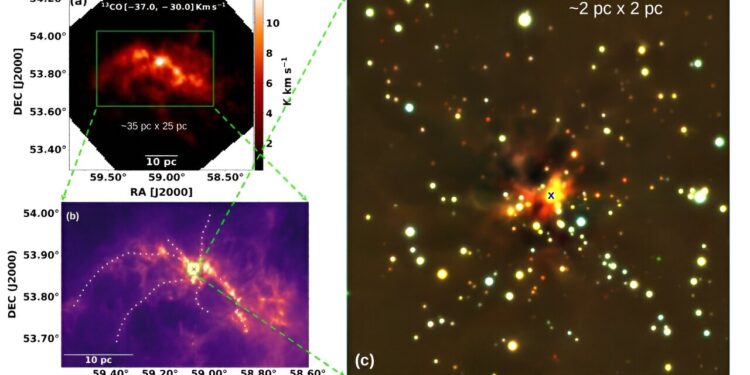(a) Distribution of CO molecular gas in G148.24+00.41. (b) 250 µm Herschel image of the inner region of the cloud. (c) Near-infrared color composite image (red: Ks band; green: H band and blue: J band) of FSR 655 as observed by TANSPEC. Credit: arXiv (2024). DOI: 10.48550/arxiv.2408.12969
Researchers have conducted detailed infrared observations of a recently formed star cluster in a giant molecular cloud called G148.24+00.41. The results of the observation campaign, presented in a research paper published August 23 on the preprint server arXivprovide important information about the nature of this group of newborns.
Located about 11,000 light-years from Earth, G148.24+00.41 is a giant, massive, cold molecular cloud. It has a radius of about 84.7 light-years, a mass of 100,000 solar masses, and the temperature of its dust has been measured at 14.5 K.
G148.24+00.41 exhibits a hub-filament morphology and shows signatures of global hierarchical collapse. In general, some giant molecular clouds exhibit filament convergence configurations, favoring the formation of clusters at junction points known as hub-filament systems.
One of these poles is located near the geometric center of G148.24+00.41 and represents its most massive cluster, designated C1. Observations in 2023 revealed that a cluster formed in the central region of C1, known as the CC region. The cluster, which has been given the designation FSR 655, appears extremely young, as it is barely visible in optical images.
Now, a team of astronomers led by Vineet Rawat of the Physical Research Laboratory (PRL) in Ahmedabad, India, has decided to take a closer look at FSR 655, with the aim of shedding light on the properties of this newly discovered cluster.
“In this work, we perform an in-depth NIR (near-infrared) analysis of the cluster, using data obtained with the newly installed 3.6-m Devasthal Optical Telescope (DOT), complemented by Spitzer observational catalogs. Our goal is to improve the understanding of the current state of the cluster in terms of its evolutionary stage, mass distribution, star formation efficiency and rate, and probable fate in the context of massive cluster formation,” the researchers explained.
Observations revealed that the current total stellar mass of FSR 655 is about 180 solar masses, while its gas mass is about 750 solar masses. The age of the cluster has been estimated to be about 500,000 years.
Based on these results, the star formation efficiency (SFE) of FSR 655 was calculated to be 19%. As for the star formation rate (SFR) of the cluster, it was measured to be about 360 solar masses per million years.
The authors of the study therefore assume that if the SFR continues at this rate, FSR 655 has the potential to become a massive cluster in the future. They estimate that it could reach a total stellar mass of about 1,000 solar masses within two million years. However, further near-infrared observations, combined with detailed simulations of the motions of the stars and gas, are needed to confirm this hypothesis.
More information:
Vineet Rawat et al, Looking into the heart of the giant molecular cloud G148.24+00.41: a near-infrared view of the newly hatched cluster FSR 655, arXiv (2024). DOI: 10.48550/arxiv.2408.12969
Journal information:
arXiv
© 2024 Science X Network
Quote: Researchers explore nature of newborn star cluster (2024, September 2) retrieved September 2, 2024 from
This document is subject to copyright. Apart from any fair dealing for the purpose of private study or research, no part may be reproduced without written permission. The content is provided for informational purposes only.



